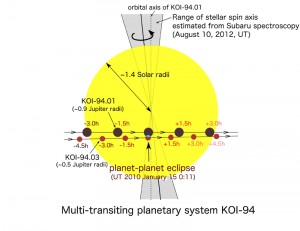First ever discovery of planet-planet eclipse Determining architecture of a multi-transiting planetary system

A group led by Teruyuki Hirano, a Ph.D student at Graduate School of Science, the University of Tokyo, has discovered a novel celestial alignment in a quadruple-transiting exoplanetary system KOI-94 (the 94th candidate system in the Kepler Object of Interest catalog). This system has been monitored by NASA’s Kepler space telescope and was known to host four planets that periodically transit the stellar disk as seen from the earth. By carefully re-analyzing the public KOI catalog, the group identified a very rare planet-planet eclipse, in which the third and the fourth planets from the star (with orbital periods of 22 and 54 days, respectively) transited the star simultaneously and even overlapped each other on January 14/15, 2010.

A schematic illustration of the KOI-94 system combining the Subaru and Kepler data © Kento Masuda
The result of the Subaru observation revealed that the orbital axis of KOI-94.01 (the third planet candidate from inside) and the spin axis of the central star are well aligned. Furthermore the analysis of a planet-planet eclipse implies that the orbital axes of KOI-94.01 and KOI-94.03 (the fourth planet candidate from inside) are also well aligned.
Such an eclipse event strongly suggests that the orbital planes of these two planets are remarkably well aligned. Indeed a detailed analysis of the data revealed that the two planets revolve around the star in the same direction and that their orbital planes are aligned to within 2 degrees. They also performed a spectroscopic observation of the system with the National Astronomical Observatory of Japan (NAOJ) Subaru Telescope on August 10, 2012, and found that the orbital axis of the third planet is well aligned with the spin axis of the central star.
Combining the Kepler and Subaru data, they concluded that the spin axis of the central star and the orbital axes of the two planets are aligned even better than those of planets in our Solar system.
This discovery provides an important observational constraint on formation and evolution of multi-planetary systems. The next planet-planet eclipse event of the system is predicted in 2026, fourteen years from now.
Press release (Japanese)
Paper
Teruyuki Hirano, Norio Narita, Bun’ei Sato, Yasuhiro H. Takahashi, Kento Masuda, Yoichi Takeda, Wako Aoki, Motohide Tamura, Yasushi Suto,
“PLANET-PLANET ECLIPSE AND THE ROSSITER-MCLAUGHLIN EFFECT OF A MULTIPLE TRANSITING SYSTEM: JOINT ANALYSIS OF THE SUBARU SPECTROSCOPY AND THE KEPLER PHOTOMETRY ”,
The Astrophysical Journal Letters Online Edition: 2012/10/23 doi: 10.1088/2041-8205/759/2/L36.
Article link
Links
Theoretical Astrophysics Group (Japanese)







